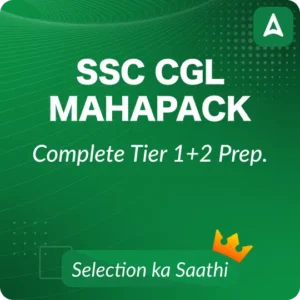Adda247 Job portal has complete information about all Sarkari Jobs and Naukri Alerts, its latest recruitment notifications, from all state and national level jobs, and their updates. These exams and jobs are regularly updated as per the official information available. Check the Latest Government Job Updates here.
We provide the latest updates on government job notifications, admit cards, exam dates, syllabi, and results. Stay informed and bookmark this page for all the latest information on government jobs and Sarkari Result 2025.
Trending
- IB ACIO Notification 2025 Out (3717 Posts), Download Official PDF
- IB ACIO Syllabus 2025, Exam Pattern For Tier 1 and Tier 2 Exam
- IB ACIO Salary 2025, Basic Pay Rs.44,900, Job Profile, Allowances
- SBI PO Syllabus 2025, Latest Exam Pattern for Prelims and Mains
- RRB Ministerial and Isolated Categories Application Status 2025 Out, Download Now
- SBI PO 2025 Exam Date Out, Prelims Exam Schedule, Call Letter
- IB ACIO Apply Online 2025 Starts 19 July, Online Form Link, Steps to Apply
- DFCCIL MTS CBT 2 Exam Date 2025, CBT 1 Exam Result
- SBI PO Admit Card 2025 Shortly, Prelims Call Letter
- DFCCIL MTS Answer Key 2025 Released, Download Response Sheet PDF
Latest Govt Jobs By Adda247
If you want all the latest updates for all Govt Jobs, Sarkari Exams, Sarkari Jobs, Admit Cards, Answer Keys, and Results of various levels of exams conducted by Government organizations, then do follow this page as we regularly update this page for all the notifications for National, State, and Central Govt exams.
If you are an aspirant and preparing for a Government Job for better career goals, job security, and long-term benefits, then you should not miss any opportunity released that fits into your eligibility and interest.
Latest Government Job 2025
The Sarkari Exam section of the website is about introducing government job seekers to get access to the results of the exams the candidates have appeared for.
The Sarkari exam section appearing on the page highlights the notification of the job results in reverse chronological order.
This section also covers the answer keys for ease of obtaining information in one place. Sarkari exam application notifications, results, admit cards and other related information can be accessed through the website, Adda247 Jobs.
We have been consistent in supplying quality information when it comes to Sarkari exam notifications of jobs, state-wise or post-wise, their admit cards, and all relevant information. The most popular type of Sarkari exam results include the Staff Selection Commission, Union Public Service Commission, Railway Recruitment Board, State Boards, Institute of Banking Personnel Selection, State Bank of India, Reserve Bank of India, Central Board of Secondary Education, and Food Corporation of India.
The website covers not only the national-level government exam results but also state-wise exam results too to get jobs in their preferred locations.
Sarkari Exams
Get immediate Sarkari Exam Alerts after official announcements by regularly visiting the website. Job seekers in the government sector are welcome at our portal to obtain suitable options for applying and getting into the job of their choice.
The latest information can be checked from the Sarkari Exam section website. As per the general exam pattern, the Sarkari exam results are released at least a month before the exam date. With the official release of the results on the government website portal, the results are also notified on the Adda247.com portal.
Govt Jobs
Here we provide the latest information regarding the Center and State Government Jobs exams, the list of a few exams is given below:
- Staff Selection Commission.
- Railway Jobs.
- Bank Jobs.
- Union Public Service Commission
- State Public Service Commission.
- State Subordinate Selection Commission.
- Naval Recruitment.
- Army Recruitment.
- Air Force Recruitment.
- National Defense Academy Examination.
- Combined Defense Services Examination
- RBI Jobs
- FCI Jobs etc.
Sarkari Jobs
The Indian Government offers several opportunities for applicants who have cleared their 10th, 12th, graduation, master’s, and diploma.
Here we cover all government jobs including RPF Constable, RPF SI, RRB Group D, RRB JE, RRB NTPC, SSC MTS, SSC JE, SSC CHSL, SSC CGL, UPSC IAS, IES, IFS, NDA, Indian Navy recruitment, UGC NET, and many other exams are covered. Most of the exams have one or more than one phase.
These exams are conducted to fill the various positions under different government departments. We keep the aspirants posted about any new updates in the exam viz. Application dates, admit card availability. We consider only the official websites as our sources of information.
Banking Exams
Every year lakhs of candidates aspire for a banking exam for a secure and promising career. Here on our page, you can find all the details of the Banking jobs and other PSU jobs in NABARD (National Bank for Agriculture and Rural Development), RBI (Reserve Bank of India), SBI (State Bank of India), IBPS (Institute of Banking Personnel Selection), and other major/minor private sector and govt. sector banks.
The banking sector jobs are a dream job for a large number of aspirants. Every year, lakhs of aspirants appear for exams such as SBI Clerk, SBI PO, IBPS Clerk, IBPS PO, IBPS RRB, RBI Officer Exam, NABARD exam, and others. The exams are conducted at the national level and selected candidates can be posted at any branch of the bank all over India.
There are generally two or three phases, namely the Preliminary, Main, and Interview phases. We ensure that the aspirants get the latest updates regarding Job Notifications, Admit Cards, and Sarkari Results related to the banking exams.
Railway Jobs
To keep an eye on the notifications released by the Indian Railway’s recruitment board (RRB) and Railway Recruitment Cell (RRC) for various railway job vacancies, we keep updating all the recruitment notifications released bythe Railways in this section.
The candidates holding Engineering Degrees have an immense scope for a better career in Indian Railways with the release of Railway notifications.
The employees are provided with excellent pay, good residence, and free travel, offered to them by the Indian government. If you are an unemployed engineering holder and looking forward to Railway Jobs, then bookmark this page to get the latest updates for Indian Railway Jobs.
Admit Cards
After completing the job application process be it online or offline., the recruitment organization releases an Admit Card/Hall Ticket/Call Letter for the eligible candidates who can appear in the written test or any other mode of selection.
We provide the Admit card links published by all the major recruiting organizations such as IBPS, Railways, Defence, SSC, UPSC, UPPSC, TNPSC, DSSSB, Vyapam, State PSC, State SSC, NDA Admit Card CDS Admit Card & many more. To stay updated with the release of the admit card for the exam you have applied for, bookmark this page and we will notify you at the very first.




